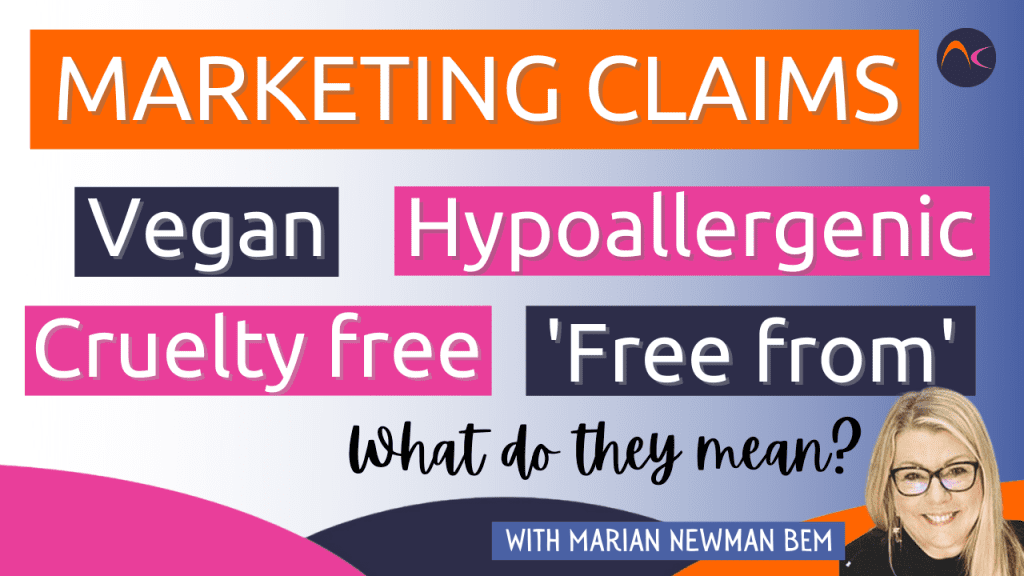Esta es una breve descripción de lo que significan (o deberían significar). Verá que muchas afirmaciones no son más que historias de marketing y no se basan en requisitos legales ni son exactas.
Las reclamaciones deben seguir ciertos criterios como mejores prácticas:
- Legal Compliance. All cosmetics fall under the Cosmetic Regulations for each country. These are very detailed, and claims should not be made if they fall under the legal requirements anyway.
- Veracidad. Las reclamaciones no deben basarse en información falsa o irrelevante.
- Apoyo probatorio. Cada alegación admisible debe estar respaldada por pruebas que la demuestren
- Honradez. Las afirmaciones no deben ir más allá de las pruebas
- Imparcialidad. Las reivindicaciones deben ser objetivas y no criticar ingredientes de uso legal en cosmética ni inducir a confusión con productos de la competencia.
- Toma de decisiones con conocimiento de causa. Deben permitir al profesional o al consumidor tomar decisiones con conocimiento de causa. Deben ser pertinentes y comprensibles para el usuario final medio.
- Hypoallergenic. This is an allowable claim if it has supporting evidence. But do not be misled by the claim. It does not mean that allergic reactions are impossible. It means that the potential is ‘below average’ so is less likely to trigger a response than those products that cannot make this claim. Nail coating products, by their nature, contain known allergens, some higher than others. But also, skin contact of uncured product should be avoided at all times (and this includes improperly cured coatings that appear cured) However, many feel more confident using this type of product and, for nails, they are unlikely to contain the more well-known allergens.
- ‘Free from’. This started as referring to traditional nail polish, but it is such a misleading claim! Some on the list that is often published are banned anyway. Some are ingredients that haven’t been used for years. Some that have been claimed to be harmful have had the claims proven to be wrong or are in such minute quantities so are negligible. One on most lists: formaldehyde, which is a gas, is not added as an ingredient but there are many cosmetic ingredients that, when chemically reacting together, release an tiny, negligible amount that is around 0.0003%
A new claim that keeps popping up is that some UV gel polishes claim to be ‘x free’. Well, the understanding of ‘free from’ relates to the list for nail polishes. Traditional nail polishes and UV gel polishes are totally different product types so the accepted ‘free from’ doesn’t apply. Now if they said ‘free from HEMA or isobornyl acrylate’ for example, it would be relevant!
- Vegan. This relates to any animal derived product and any animal cruelty. Virtually ALL nail coatings have no animal products included so they are all vegan. The only very rare exception is if the pigment carmine is used but this has been long replaced by alternatives. For strict vegans there are a few ingredients that may be objected to. Examples of these could be lanolin (derived from sheep wool) and bees wax (harvested from hives). The animals are not harmed in the collection of these but there is obviously a strong connection
- Cruelty free. There is no animal testing on finished cosmetic products anywhere in the world. The brand can use the ‘cruelty free’ logo but only under certain circumstances which are, briefly, that the manufacturer and their suppliers have not commissioned any animal testing on any product or any of its ingredients. All cosmetic products are inherently cruelty free so, in many ways, it is not needed as a claim nor the logo.
Curiosamente, en el Reglamento de Aplicación de Productos Cosméticos de 2013 (que también se aplicará en el Reino Unido a partir del 1 de enero de 2021), el artículo 21 establece que cierta información debe ponerse fácilmente a disposición del público.
You will see how some claims do not fall in line with ‘best practices’! Notice #5!!!
In conclusion, understanding is essential! Don’t get taken in by claims that stretch a point! Some (and by no means all) can be misleading, inaccurate or even wrong! It’s an over saturated market and brands need to make their mark. Buy from trusted and authorised sources and you should be fine.


